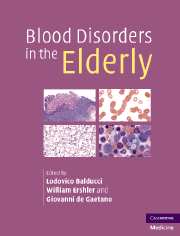Book contents
- Frontmatter
- Contents
- List of contributors
- Preface
- Part I Epidemiology
- Part II Hematopoiesis
- Part III Anemia of aging
- Part IV Hematologic malignancies and aging
- 18 Cancer chemotherapy in the older person
- 19 Acute myeloid leukemia in the elderly
- 20 Acute lymphoblastic leukemia in the elderly patient: diagnosis and therapy
- 21 Multiple myeloma
- 22 Non-Hodgkin lymphoma
- 23 Unusual lymphomas in the elderly
- 24 Chronic lymphocytic leukemia in the elderly
- 25 Polycythemia vera and idiopathic myelofibrosis in the elderly
- Part V Disorders of hemostasis in the elderly
- Index
22 - Non-Hodgkin lymphoma
from Part IV - Hematologic malignancies and aging
Published online by Cambridge University Press: 21 October 2009
- Frontmatter
- Contents
- List of contributors
- Preface
- Part I Epidemiology
- Part II Hematopoiesis
- Part III Anemia of aging
- Part IV Hematologic malignancies and aging
- 18 Cancer chemotherapy in the older person
- 19 Acute myeloid leukemia in the elderly
- 20 Acute lymphoblastic leukemia in the elderly patient: diagnosis and therapy
- 21 Multiple myeloma
- 22 Non-Hodgkin lymphoma
- 23 Unusual lymphomas in the elderly
- 24 Chronic lymphocytic leukemia in the elderly
- 25 Polycythemia vera and idiopathic myelofibrosis in the elderly
- Part V Disorders of hemostasis in the elderly
- Index
Summary
Introduction
Non-Hodgkin lymphoma (NHL) is a topic of increasing significance in an aging population. According to the National Cancer Institute's SEER program, the overall incidence of NHL increased by 75% between 1973 and 1994, or approximately 3% each year. However, not only is the incidence rising, but one-half of all lymphomas are diagnosed in patients over 65 years of age, and the incidence by age keeps increasing at least until age 85. In the context of an aging population, the absolute number of patients over 65 years with lymphoma is expected to double within the next 25 years. Fortunately, our understanding of lymphoma biology is also steadily growing, leading to innovative treatments that capitalize upon this new understanding.
Lymphomas are biologically heterogeneous, and for most subtypes the etiology is unknown. Although epidemiologic factors, often incompletely understood, such as geography, environmental exposure, immunodeficiency, and specific preconditions, play a role, there is a strong relationship between aging and the development of NHL. To some extent this may relate to exposure and opportunity, but with aging also come aberrations in immune function and response. The heterogeneity of lymphomas extends to their clinical behavior. Although the behavior of specific subtypes of NHL tends to be similar regardless of age, the impact of the disease and the individual's ability to tolerate the necessary interventions may vary.
- Type
- Chapter
- Information
- Blood Disorders in the Elderly , pp. 290 - 310Publisher: Cambridge University PressPrint publication year: 2007

